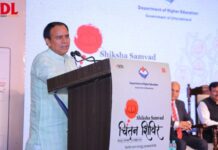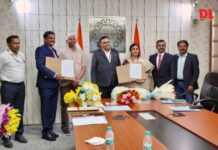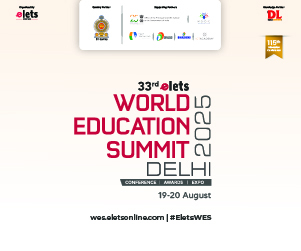I've come to India because something remarkable is happening in education for the poor and I want to be a part of it. There's a private education revolution taking place
Private Schools For Poor
Use of ICT in Education
The mere presence of computers and other new technologies in the classroom is not sufficient; ICT interventions need to be designed and implemented strategically in order to be effective and live up to their full potential
Information and Communication Technologies (ICT) have great potential to develop access, quality and equity in education at all levels
Striving To Make India a Knowledge Society
 India’s education sector today faces multiple challenges of access, equity and quality. Over the past five years, Ministry of Human Resource Development has been busy in attaining the goal of making education accessible to every child, particularly among the marginalised sections in the rural areas. We are also addressing the gap that exists between the market demands and the available skill sets among professionals through the participation of private sector in the curriculum framework.
India’s education sector today faces multiple challenges of access, equity and quality. Over the past five years, Ministry of Human Resource Development has been busy in attaining the goal of making education accessible to every child, particularly among the marginalised sections in the rural areas. We are also addressing the gap that exists between the market demands and the available skill sets among professionals through the participation of private sector in the curriculum framework.
Coming to the aspect of quality, infrastructure and faculty are two major concerns that need to be focused on. We are roping in as many colleges as possible under the ambit of the University Grants Commission (UGC) to upgrade their quality. The UGC and AICTE are also pursuing various measures to lure fresh graduates into research and teaching profession.
The government alone cannot address all these challenges. The private sector needs to play a proactive role to supplement the efforts of the government. A PPP model is to be developed with the active participation of stakeholders at the central and state level.
The 11th Five Year Plan has kept a target of raising the gross enrollment ratio to 15% by the end of the plan year. This is where ICT steps in. Integration of ICT in education will give an impetus to our efforts to attain our target of increasing our gross enrollment ratio by widening the reach of education to the remote and marginalised areas of our country.
With a large percentage of our population constituting the workforce, ICT also gives them space to pursue education at their own convenient pace and time. The role of Open and Distance Learning (ODL) systems, which have accepted and integrated ICT in their functioning and outreach, particularly finds mention here.
As we all know education is what ultimately decides the position of a country in the comity of nations, we should all strive to make India a knowledge society. This is what my ministry aspires for and I hope all the stakeholders put in their best in achieving this.
I also take this opportunity to wish ‘digital Learning’, a leading magazine on ICT and education, on the occasion of its third anniversary. The magazine has played a key role in providing a platform to all the stakeholders to voice their views and opinions. I hope it carries on this role for many more years to come!
I am also happy to know that the publishers of digital LEARNING magazine are organising the eINDIA 2009 on 4-6 August 2009 in the National Capital Region of Delhi. I congratulate the organisers on this endeavour. I am pleased to know that my Ministry is actively participating and supporting this path-breaking event. I wish this event a great success.
World News:January 2009
e-Learning Initiative launched by UN
A new UN e-Learning initiative launched on December 6 in Berlin. This will offer developing countries opportunities to draw upon a rich array of training and capacity-building resources. At a forum meeting organised by the United Nations Environment Programme (UNEP) during Online Educa Berlin, 16 UN agencies agreed to establish UNeLearn
Shattering Barriers in Education With ICT

 Sudiksha Learning Dimensions was founded in 2002 with the mission of offering innovative learning solutions using ICT and other tools. It offers end-to-end e-Learning services for enterprises, NGOs and educational institutes.
Sudiksha Learning Dimensions was founded in 2002 with the mission of offering innovative learning solutions using ICT and other tools. It offers end-to-end e-Learning services for enterprises, NGOs and educational institutes.
As an ecosystem alliance partner with Intel for its Classmate PC solution, Sudiksha is now announcing a path breaking new offering, the e-SchoolNetwork Program (eSN).
The eSN idea emerged when Sudiksha's academic and pedagogy team observed children learn in different schools. They also interviewed many adults who were able to solve advanced problems in school curriculum even decades after completing their schooling. When probed, these adults could visually recall the exact learning interaction when a particular concept was thought in great detail. (In one case, this included a memory that the teacher had dyed her hair on that day!) All this validated what they had learnt about pedagogy and effective teaching. Some of the key factors noted were:
-
The clarity of concept is a function of the level of engagement of the student at the time of learning the concept. For example, a child who acted in a play about Emperor Ashoka demonstrated great confidence in dates, acts and events related to the same topic.
-
A strong foundation in the primary or middle school level facilitates the ability of a child to build upon the concept in the later years. For example, if a child had internalised the process of skip counting well, then in the 2nd grade, concepts like multiplication tables and reading time on a clock become relatively simple.
On the other hand, if a child had difficulty in visualising skip counting in the first place, then learning tables by rote or trying to learn by heart what the various positions of the hands of a clock mean can become a nightmare.
-
Concept clarity in the early years ensures long-term retention and accelerated learning.
For example, when asked, 'What is respiration?' The most common answer across age groups is, 'Breathing in and Breathing out.' It takes a lot of sweat and toil for high school Biology teachers to correct this view of respiration!
These points May sound very familiar but unfortunately, many children, parents and teachers are grappling with school level education. Not even a rank holder would claim that getting through school exams is child's play!
Coming to our education system, it is indeed very difficult for a single human to address the learning needs of different children in the same class. With student-teacher ratio ranging from 20 to 60, in any modern day school, millions of little knowledge gaps slip through the chinks in the system. Models like Differentiated Classrooms and 1-on-1 learning have evolved to fill these gaps in traditional education.
The eSchool Network Program is designed using a unique collaborative design approach. This approach involves a team of diverse stakeholders including, Education Psychologists, Special Educators, Teachers, Theatre Professionals, New Media Experts and most importantly Children. The design process is aimed at creating academically sound products, which elicit voluntary and happy learner engagement.
The eSN will constantly evolve under the vigil of its stakeholders. Users can access paid and free services on this portal. The Intel powered CMPC is a great way for children to use eSN features. In collaboration with Intel, Sudiksha plans to facilitate implementation of CMPC based Differentiated Classroom and hand hold teachers.
ICT has unquestionably improved the quality of our lives in many ways. We connect, communicate and collaborate in our personal and professional lives. Education cannot be far behind!
For more information contact info@sudikshaindia.com
Project Prakash
India utilises public-private partnerships through SPVs or bidding processes to set up roads, ports, airports, health and educational infrastructure. PPP is also being used as a way to meet the challenges presented by the education sector. In PPP projects the various stakeholders contribute not just finance but bring in expertise and project management talents. Advantages include: cost sharing; risk sharing; knowledge and resource sharing; and innovations to meet challenges.
Creating Social Infrastructure — IL&FS Education and Technology Services
IL&FS Education and Technology Services (IETS), was set up in 1997 by IL&FS — a pioneer in public-private partnerships in India. IETS is working with several state governments in various aspects of education such as creation of multi-media learning modules for transmission through EDUSAT; computer aided learning; capacity building of teachers; English language teaching; classroom management; soft-skills training; as well as design and implementation of MIS systems for schools.
Project Prakash
Among the many projects is a partnership with the Pimpri – Chinchwad Municipal Corporation and the Science and Technology Park to transform 152 schools to global standards. This holistic transformation project will impact around 60,000 students.
Conceived as an 'integrated project', Project Prakash is all set to change the way teaching-learning takes place. Goals and interventions in the transformation process were set by a Joint Review Mission, which assessed the status of schools, defined areas in need of improvement, and recommended action points. Each intervention is planned in an integrated manner with the participation of every stakeholder.
The project is focusing on providing quality education from Balwadi to 10th standard students. Specific interventions are designed to uplift the performance of students with special needs. All the 152 schools of PCMC will undergo transformation to meet global standards in all aspects of education such as:
-
Create multimedia content based on syllabus
-
Introduce English, Math, and Science kits
-
Introduce Computer Aided Learning for students and teachers
-
Train teachers in English, IT, Classroom Management, Behavior Modification techniques and care of special needs children
-
Set up state of art IT infrastructure in terms of computer labs with Internet connectivity
-
Linking of all schools through WAN
-
MIS systems for administration
-
Intranet and Internet website and portals for the schools
The partnership will go on for a period of three years and in that time the PCMC schools will be self sufficient, achieve global standards, and contribute towards the creation of a knowledge based society.
The year that was 2008!
As we prepare to usher in a New Year, the year that we bid adieu will go down in history as one of the most eventful phases in the past decade or so. Its impact on the coming years will be significant and defining. The world slipped into the grip of a financial crisis with the world’s top economy, the US taking a severe battering with its credit crisis. The financial markets have nosedived. The market demands and production are running low.
But so much for the bad news; a fresh start also requires revisiting the core strengths and solid fundamentals. We turn three with the onset of 2009. In this anniversary issue of Digital Learning we share such moments.
Some numbers to start with. In 2007 around hundred authors gave content for the magazine; this grew to 130 authors sharing their ideas through our magazine in 2008. We have in the past year carried forward the mission of forging alliances for ICT content showcasing growth in the education sector.
We received contributions from India, Malaysia, USA, UK, Philippines, China, Thailand, Indonesia, South Africa, Bangladesh, Singapore, China, Pakistan, Canada and Turkey. To add to the list we received additional contributions in 2008 from Russia, Israel, Kenya, Ghana, New York and Australia. This showcases Digital Learning expanding global reach.
Digital Learning delivered total of 778 pages of content in its twelve issues of 2008, out of which 228 were generated in-house articles. In 2008, the themes that featured included ‘a futuristic outlook on ICT, education planning, distance education, Asian scenario on e-Education, and Malaysian scenario.
This anniversary issue brings together a composite outlook, spanning across government and private, schools and universities, from India’s education sector and the role that ICT is already playing in making quality education possible for millions.
We hope you will enjoy reading the new-look Digital Learning.
We wish you all a very happy new year!
1000 new polytechnics planned for India
Vocational Education in India is getting impetus from the government through its schemes and financial outlay for skilled workforce.
Central government announced to open 1000 new polytechnics across the country under a nation wide scheme of 'Sub-Mission on Polytechnics' to be opened under Co-ordinated Action for Skill Development. The scheme aims to benefit grass root enterprises and facilitate technology transfer.
The government under the revised scheme of Community Polytechnics has a total outlay of Rs.737.82 crores to over 1000 polytechnics have been outlined to be implemented during the 11th and 12th Five-Year Plan.
The HRD Ministry has planned financial arrangements of a one time central grant for 300 polytechnics and Private Public Partnership (PPP) mode for another 300. The remaining 400 polytechnics would be set up through complete private funding.
As a part of programme, there are also proposals to augment the skill development among women by giving grants to the same numbers polytechnic colleges with an allocation of Rs.1 crore each.
UP scores 25 per cent in NAAC test
Uttar Pradesh scored 116 out 461, for NAAC accreditation recognized colleges. The poor performance of the colleges has had the state finance department revising their financial planning roadmap for colleges in the state, finding ways to pave way for quality education in the state.
461 degree colleges set up and aided directly by the government in the state, only 116 of them, are recognized by the National Accreditation and Assessment Council (NAAC). The state finance department said that there was no need for setting up new government degree colleges in the state, instead the state needs to emphasisd the need for bringing about a qualitative improvement in the academic standards of these institutions.
The department urged the dismal state of state's higher education system calls for a drastic shift in the existing policy from that of quantity to quality. The state's roadmap for quality higher education includes setting up of library, e-learning, conference rooms etc. All degree colleges would be made centres for vocational courses as well as placement cells, first phases in all the government colleges will be introduction of computer-based courses.
15,000 teachers sacked in Bihar
Bihar Government has sacked 15,000 teachers recruited last year for producing certificates from unrecognised B.Ed Colleges.
The move follows the state governments' act of blacklisting B.Ed colleges in India and Nepal to check the fake degree racket and irregularities in the ongoing second phase of the recruitment drive. Their degrees were from institutes recognized neither by the state government nor the National Council of Teachers Education (NCTE).
Following local media reports about candidates for teaching jobs having presented fake degrees, the government directed that all documents be verified by the concerned institutions or universities.
The sacked teachers were appointed last year as part of the first phase of a recruitment drive for government-run schools.



















